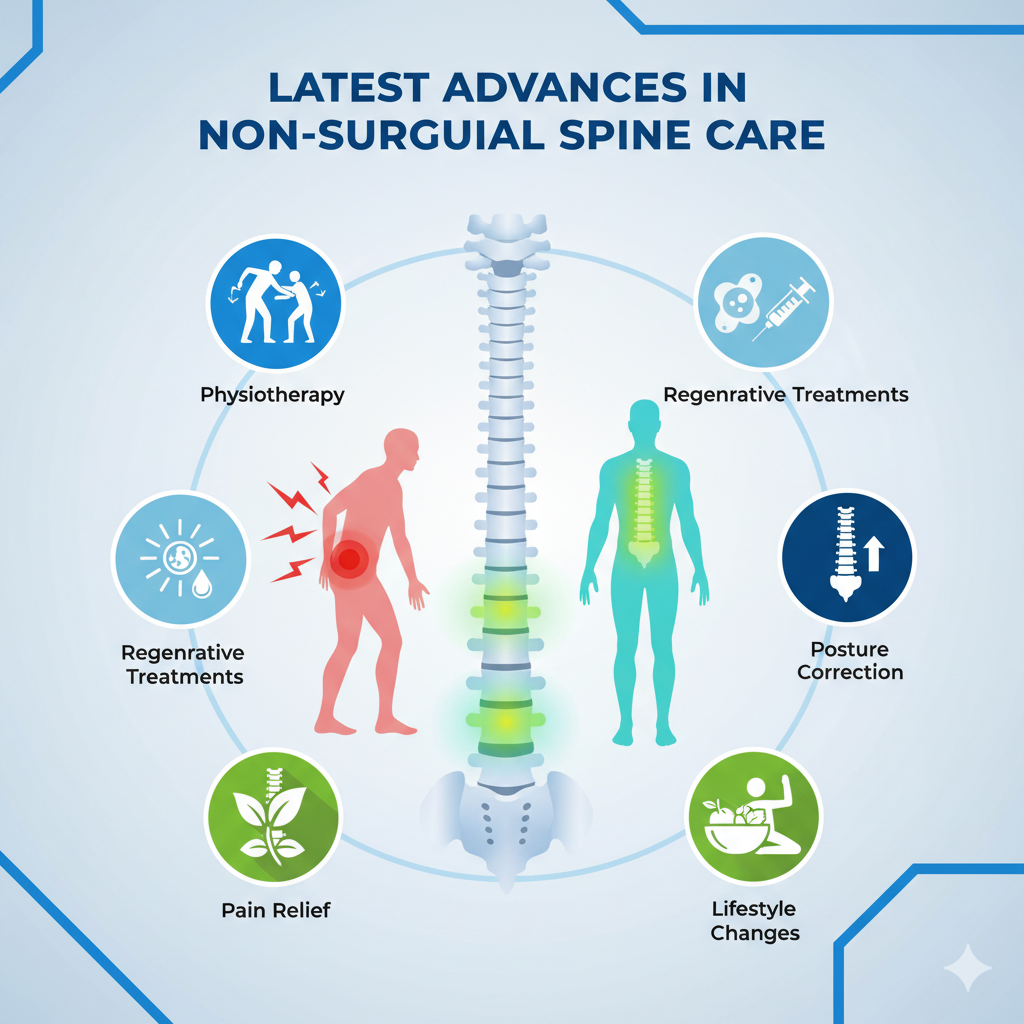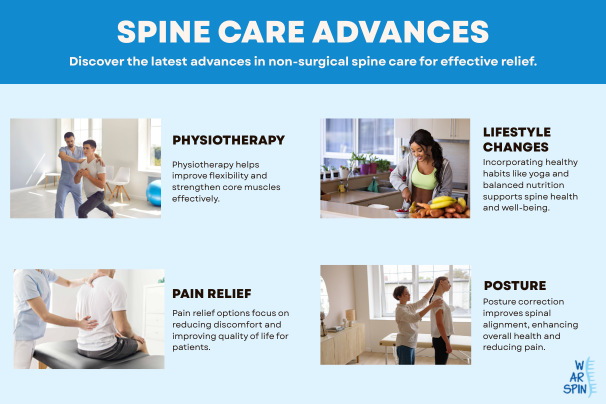
Spine problems are no longer limited to the elderly. With modern lifestyles that involve long hours of sitting, minimal physical activity, and digital device overuse, spinal conditions like slip discs, sciatica, cervical spondylosis, and chronic back pain are increasingly common in young and middle-aged adults. Traditionally, severe back or neck issues often led people to believe surgery was the only solution. However, medical science has made significant progress in non-surgical spine care, offering safer, effective, and long-lasting treatments that avoid the risks associated with surgery.
If you are searching for the best spine care solutions, you’ll be glad to know that today’s non-invasive and minimally invasive treatments combine advanced technology, physiotherapy, regenerative medicine, and lifestyle modifications. This article explores the latest advances in non-surgical spine treatment that are reshaping how patients recover from spinal problems.
Why Non-Surgical Spine Care Matters
Before diving into the latest innovations, it is important to understand why non-surgical approaches are gaining more attention worldwide:
- Lower risk compared to surgery: No anesthesia, surgical scars, or hospital stays.
- Faster recovery time: Patients often resume daily activities sooner.
- Cost-effective: Non-surgical treatments are generally more affordable than surgery.
- Focus on long-term health: Treatments aim at rehabilitation, posture correction, and lifestyle changes.
Spine specialists and physiotherapists now prefer these approaches whenever possible, recommending surgery only when absolutely necessary.
Regenerative Medicine in Spine Care
One of the most exciting areas in advanced spine treatment is regenerative medicine, which uses the body’s natural healing mechanisms to repair damaged tissues.
Stem Cell Therapy
- Uses stem cells harvested from the patient’s own bone marrow or fat tissue.
- Helps regenerate damaged spinal discs or cartilage.
- Reduces inflammation and promotes natural healing.
Platelet-Rich Plasma (PRP) Therapy
- Involves drawing the patient’s blood, processing it to concentrate platelets, and injecting it into the affected spine area.
- Platelets release growth factors that accelerate tissue repair.
Benefits:
- Minimally invasive
- Can reduce chronic pain
- May delay or even prevent the need for surgery
Image-Guided Injections for Precision Treatment
Traditional pain injections were often given without precise targeting, but now advanced imaging like fluoroscopy and ultrasound has revolutionized their accuracy.
Epidural Steroid Injections (ESIs)
- Used to reduce inflammation around irritated nerves (commonly in sciatica or herniated discs).
- Provides significant short- to medium-term pain relief.
Facet Joint Injections
- Target the small joints between vertebrae that often cause localized pain.
Nerve Blocks
- Temporarily interrupt pain signals sent from the nerves to the brain.
With imaging technology, doctors can now deliver medications with pinpoint accuracy, minimizing side effects and maximizing results.
Minimally Invasive Pain Procedures
Non-surgical does not mean “no procedure.” Some minimally invasive techniques are highly effective for chronic back pain patients who don’t respond to conservative care.
- Uses heat generated by radio waves to “switch off” specific pain-carrying nerves.
- Relief can last for months or even years.
Cryoablation
- Freezes the targeted nerve to stop pain signals.
These techniques have transformed spine care by giving patients longer-lasting relief without the risks of major surgery.
Advances in Physiotherapy and Rehabilitation
Physiotherapy has always been the foundation of non-surgical spine treatment. Today, it has evolved with technology and science-backed approaches.
Robotic-Assisted Rehabilitation
- Robotic devices guide patients through precise movements, improving muscle control and posture.
AI-Guided Exercise Programs
- Apps and platforms analyze patient progress and adjust exercise difficulty in real time.
Manual Therapy + Technology
- Traditional hands-on techniques are now combined with ultrasound therapy, laser therapy, and electrical stimulation to enhance recovery.
Spinal Decompression Therapy
This is a non-surgical, traction-based treatment that relieves pressure on spinal discs and nerves.
- Involves a motorized table that gently stretches the spine.
- Creates negative pressure inside the discs, encouraging retraction of herniated material.
- Promotes nutrient-rich fluid flow for healing.
Studies show that patients with slip discs or chronic lower back pain often benefit from this therapy when combined with physiotherapy and lifestyle changes.
Wearable Technology for Spine Care
Wearables are no longer just for fitness tracking; they now play a role in spinal health.
- Posture-correcting wearables: Alert users when they slouch.
- Smart braces: Provide support while allowing mobility.
- Mobile health apps: Track pain levels, daily activity, and recovery progress.
This trend empowers patients to take charge of their spine care on a daily basis.

The Role of Lifestyle Medicine in Spine Health
One of the biggest advances in spine care is not a device or drug—it’s a holistic approach. Modern spine specialists now emphasize lifestyle medicine as an essential part of treatment.
Exercise and Movement
- Regular stretching and strengthening exercises prevent stiffness and maintain spinal flexibility.
- Core-strengthening workouts support the spine and reduce the risk of disc-related problems.
Ergonomics
- Adjustable chairs, sit-stand desks, and ergonomic keyboards can prevent posture-related strain.
- Work-from-home setups are now being tailored with spine health in mind.
Sleep and Recovery
- Orthopedic mattresses and proper sleeping positions reduce spinal stress.
- Sleep tracking technology helps identify poor sleep patterns that may worsen pain.
By treating the root causes (sedentary lifestyle, poor posture, excess weight), lifestyle medicine reduces dependency on drugs or surgery.
Yoga and Mind-Body Therapies
Non-surgical spine care increasingly recognizes the connection between mental health and back pain. Stress, anxiety, and poor lifestyle habits can worsen spinal problems.
Yoga Therapy
- Poses like Cat-Cow, Child’s Pose, and Cobra improve flexibility and reduce stiffness.
- Focuses on deep breathing, posture awareness, and body balance.
Mindfulness and Meditation
- Helps manage chronic pain perception.
- Reduces stress hormones that contribute to muscle tension.
Hospitals and spine care centers are now offering integrated yoga-based rehabilitation programs, combining traditional wisdom with medical guidance.
Nutritional Support for Spinal Healing
Nutrition is often overlooked in spine care, but it plays a key role in recovery.
Key Nutrients for Spine Health
- Calcium & Vitamin D: Essential for strong bones.
- Magnesium: Reduces muscle spasms.
- Omega-3 fatty acids: Natural anti-inflammatory properties.
- Collagen & protein: Support disc and cartilage health.
Specialized diet plans now form part of advanced non-surgical treatment to support healing and prevent recurrence of spine problems.
Telemedicine and Digital Spine Care
The COVID-19 pandemic accelerated the adoption of virtual spine consultations. Today, telemedicine is a mainstream part of spine treatment.
- Patients can consult the best spine clinic without geographical barriers.
- Video assessments help doctors evaluate posture and mobility.
- Digital physiotherapy sessions guide patients through exercises at home.
This digital shift makes spine care more accessible, especially for patients in rural or remote areas.
FAQs on Non-Surgical Spine Care
Q1. Is non-surgical spine treatment as effective as surgery?
In many cases, yes. For slip discs, sciatica, and chronic back pain, non-surgical options like physiotherapy, injections, and regenerative medicine can provide long-term relief without surgical risks. Surgery is recommended only if symptoms are severe or progressive.
Q2. How long does it take to see results from non-surgical spine care?
It varies. Some patients experience relief within weeks of physiotherapy or injections, while regenerative therapies may take months to show full results. Consistency is key.
Q3. Are there risks in non-surgical treatments?
Most are safe, but minor risks include soreness after injections, temporary stiffness, or incomplete relief. Compared to surgery, the risks are minimal.
Q4. Can slip discs heal without surgery?
Yes. Many slip discs improve with physiotherapy, decompression therapy, and lifestyle changes. Surgery is required only in severe cases where nerve compression causes loss of function.
Q5. What is the cost difference between surgical and non-surgical care?
Non-surgical treatments are generally much more affordable. Surgery involves hospital stays, anesthesia, and recovery costs, while non-surgical care often requires outpatient visits and therapy.
The Role of Exercise and Physiotherapy Protocols
Non-surgical spine care is not a single technique but a comprehensive approach. Physiotherapists now rely on evidence-based exercise protocols tailored to each condition:
- For Slip Disc: McKenzie Method (directional preference exercises to centralize pain).
- For Sciatica: Nerve gliding (mobilization exercises that reduce nerve compression).
- For Cervical Pain: Isometric neck strengthening combined with posture retraining.
- For Chronic Back Pain: Core stabilization and Pilates-based movements.
These aren’t just “gym exercises.” They’re targeted, medically guided routines with proven outcomes in clinical trials.
Conclusion: Choosing a Smarter Path to Recovery
The latest advances in non-surgical spine care—from regenerative medicine to AI-driven rehab—are transforming outcomes for patients worldwide. Evidence shows that for slip disc, sciatica, and most chronic back or neck pain cases, conservative treatment is effective, safe, and sustainable.
For individuals living with pain, the key is not only to seek treatment but also to stay consistent with exercises, posture habits, and lifestyle changes. With better awareness, tools, and support systems, it’s possible to live a full and active life—without surgery in most cases.